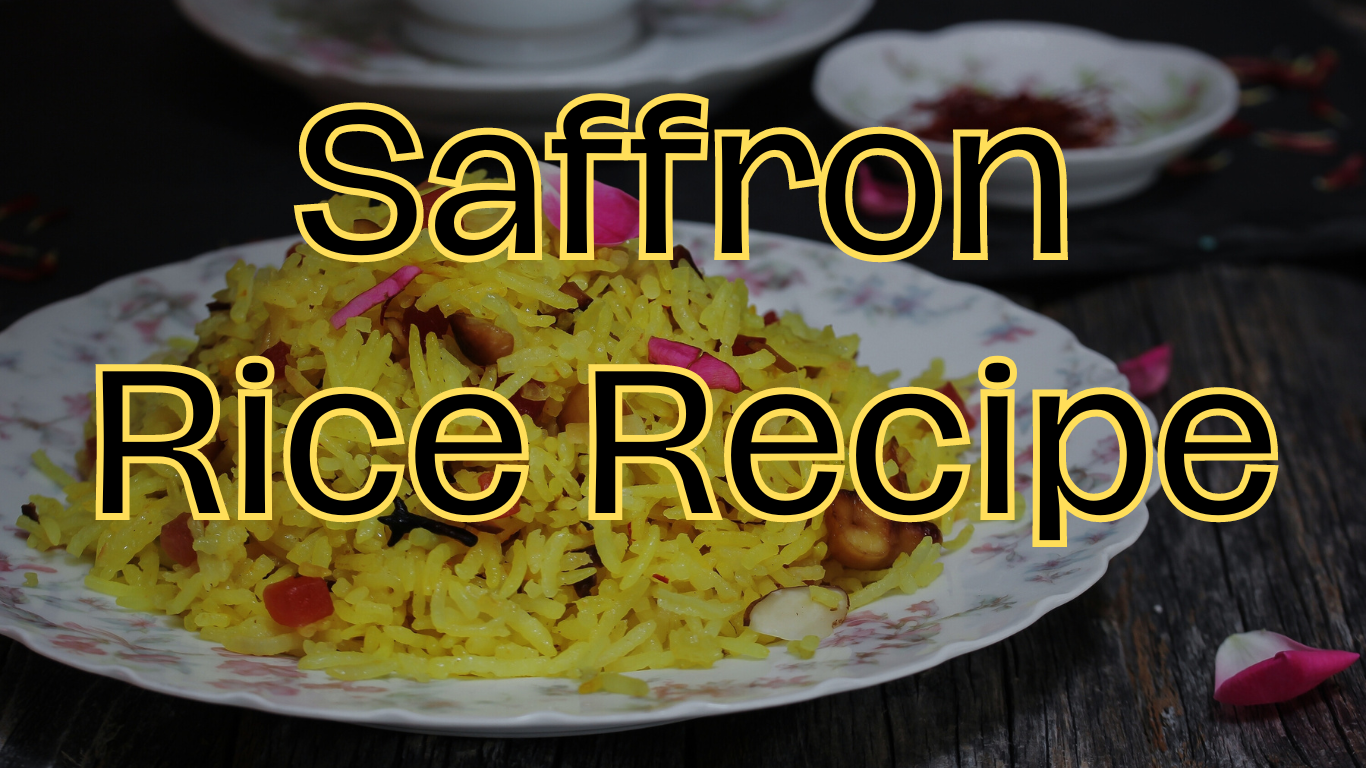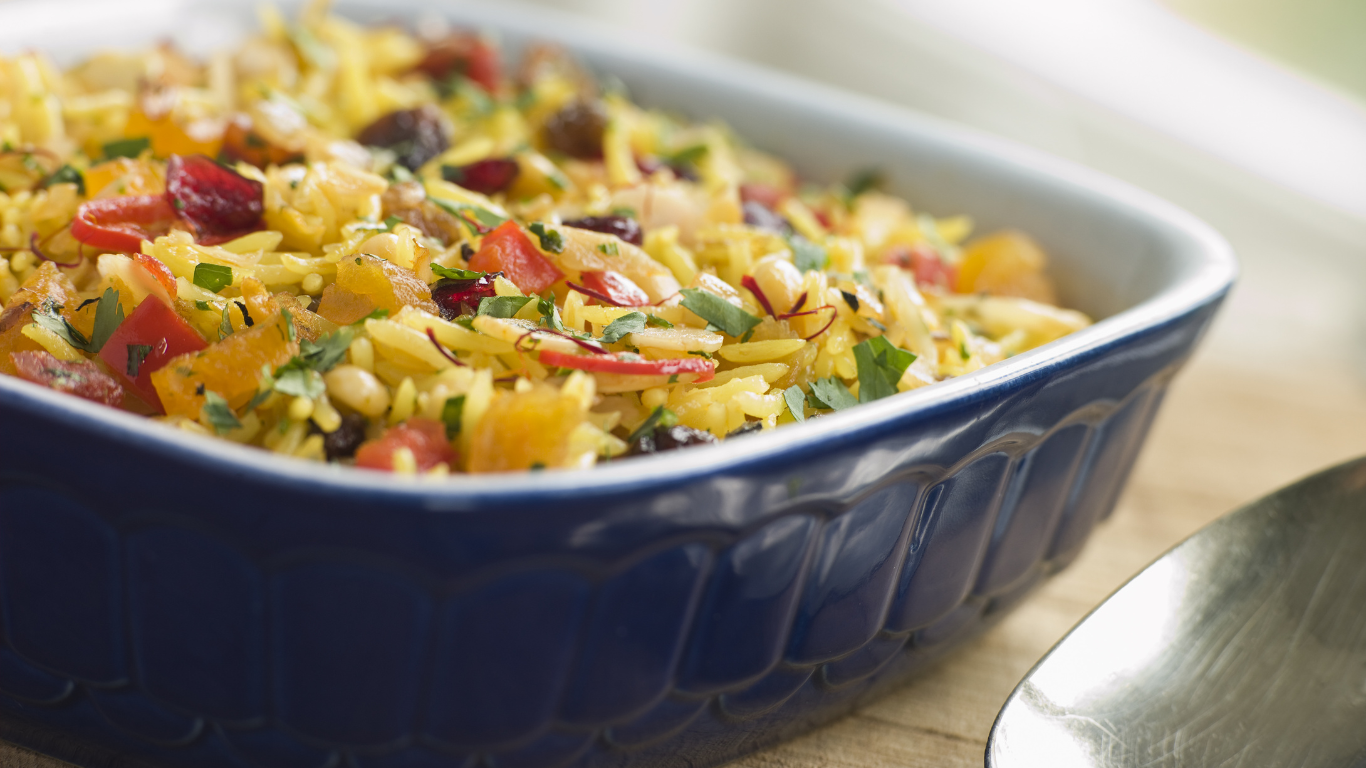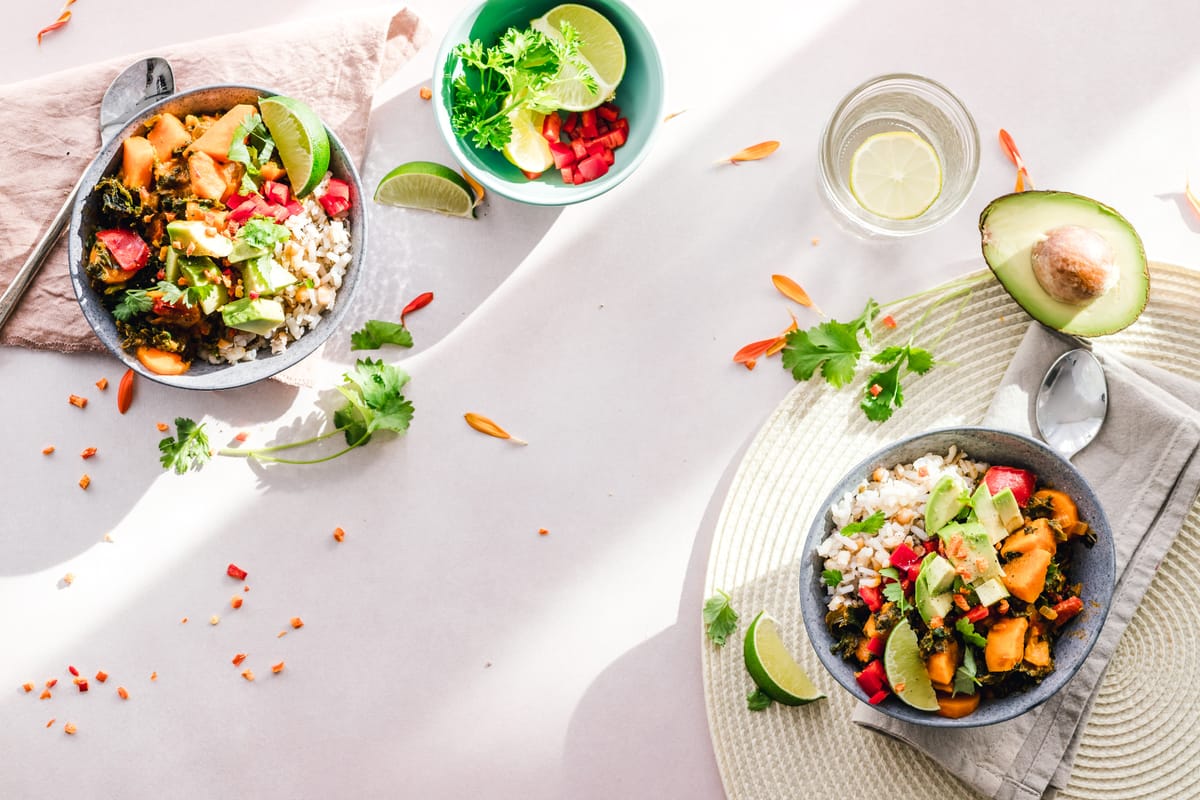Exotic and Aromatic: Journey through Flavors with our Saffron Rice Recipe!
Discover the secrets to creating a delectable saffron rice recipe: aromatic, flavorful, and perfect for any occasion. Elevate your culinary skills in the kitchen in your spare time!

Are you tired of the same old boring dishes? Feeling stuck in a culinary rut? We feel your pain. But don’t worry, we’ve got you covered with our exquisite Saffron Rice Recipe. This elegant, fragrant dish may seem intimidating, but it’s simpler to prepare than you think. Not only will you add an exotic touch to your meals, but you'll also impress your guests at your next dinner party. Read on and let's bring the flavors of the Middle East to your kitchen.
Brief history and cultural significance of saffron rice
Saffron rice, also known as "pilaf" or "pulao," is a delightful dish that has been enjoyed for centuries in various cultures around the world. Its origins can be traced back to ancient Persia, where saffron was highly prized for its vibrant color and distinct flavor. Saffron was considered a luxurious spice and was often used in royal feasts and special occasions.
The cultural significance of saffron rice extends beyond its historical roots. It has become an integral part of many traditional celebrations, such as weddings, festivals, and religious ceremonies.
In certain cultures, serving saffron rice symbolizes prosperity, joy, and abundance. This dish is a centerpiece on tables during festive gatherings. It has a fragrant aroma and beautiful appearance.
Overview of the ingredients and equipment needed
To make saffron rice at home, gather a few key ingredients. These ingredients combine to create a delicious blend of flavors. Saffron threads are the star ingredient, undoubtedly. These crimson-colored strands offer a subtle yet captivating earthy flavor.
Make sure to choose high-quality saffron threads to ensure the best results. You will need long-grain basmati rice. It is renowned for its aromatic properties and fluffy texture when cooked.
Other common ingredients are warm water, used to infuse the saffron. Additionally, ghee or butter is added for richness. Salt is also included to season the dish. Optional spices, such as cardamom pods or cinnamon sticks, can be used as well. To prepare saffron rice, you need a saucepan with a tight-fitting lid. The rice must cook properly.
A fine mesh strainer comes in handy for rinsing the rice before cooking to remove any excess starch. Additionally, having a mortar and pestle can be useful for grinding whole spices like cardamom pods or cinnamon sticks if you opt for using them.
Let's begin by exploring the foundation of saffron rice recipe. We'll cover its history, cultural significance, ingredients, and equipment requirements. Once we have this overview, we can delve into preparing the dish. Get ready to embark on a culinary journey that will fill your kitchen with delightful aromas and your taste buds with pure satisfaction!
Preparing the Saffron
Explaining the origin and harvesting process of saffron
Saffron, known as the "red gold," is a precious spice that has been cherished for centuries. The saffron spice comes from the crocus flower. It is mostly grown in Mediterranean regions like Iran and Spain. Kashmir is also a prominent area for cultivation. The process starts in autumn by planting saffron crocus corms carefully.
These corms then develop into beautiful purple flowers with bright orange-red stigmas. The magic happens during harvest time when skilled farmers carefully pick the delicate threads by hand before dawn.
Preserving the quality and potency of saffron requires labor-intensive methods. These methods are essential to maintain its vibrant color and distinct flavor. Each crocus flower yields only three stigmas, which are then dried to intensify their aroma.
Tips on selecting high-quality saffron threads
When it comes to saffron selection, quality is paramount. To ensure you acquire top-notch threads, keep these tips in mind:
- Look for vivid color: Genuine saffron should have deep red strands which indicate its potency.
- Avoid pale or yellowish threads as they may be inferior or diluted. 2. High-quality saffron has a strong, sweet fragrance like honey and hay.
- Avoid any musty or stale odors. 3. Seek reputable sources. Purchase from suppliers specializing in authentic spices. Choose those with positive customer reviews.
- Consider certification. Look for certifications like ISO 3632-1 or DOP labels. The certifications help with grade classification and protected origin. These certifications ensure authenticity and adherence to strict standards.
- Genuine saffron is costly because it is labor-intensive to cultivate. If an offer seems too good to be true, it probably is.
Step-by-step guide on how to infuse saffron in warm water
Infusing saffron correctly is crucial to unlock its flavor and color. Follow these steps for a perfect infusion:
1. Measure the quantity: Determine the amount of saffron needed for your recipe. Usually, a pinch or around 20-30 threads are enough for a serving.
2. Heat the water: Warm some water without bringing it to a boil. The ideal temperature is approximately 175°F (80°C).
Avoid using boiling water as it can degrade the delicate compounds in saffron.
3. Crush the threads: Place the saffron threads in a mortar and gently crush them into smaller pieces.
This step helps release more flavor and color during infusion.
4. Combine and steep: Add the crushed saffron threads into the warm water and let them steep for at least 15 minutes, allowing their vibrant attributes to infuse into the liquid.
5. Stir and use: Before using, give the mixture a gentle stir with a spoon to ensure an even distribution of color and flavor throughout your dish. By following these steps, you will harness the full potential of this precious spice while adding an unforgettable touch to your culinary creations.
Different Rice Varieties Suitable for Saffron Rice Recipe
Choosing the right rice variety is crucial for a delectable saffron rice dish. While basmati rice is the traditional choice, other options can also yield fantastic results.
Basmati rice is renowned for its long grains, delicate fragrance, and fluffy texture when cooked. This aromatic rice variety pairs exceptionally well with the subtle flavors of saffron.
However, if basmati rice is not available, you can opt for jasmine or long-grain white rice as alternatives. Keep in mind that different varieties might slightly alter the overall taste and texture of your saffron-infused masterpiece.
Detailed Instructions for Rinsing and Soaking the Rice Properly
To achieve perfectly cooked and separated grains in your saffron rice, it's vital to rinse and soak the rice beforehand. Start by measuring out the desired amount of rice using a cup or kitchen scale. Rinse the grains under cold water until the water runs clear, removing any excess starch that may hinder proper cooking.
After rinsing, transfer the washed rice to a bowl and cover it with enough cold water to submerge it completely. Allow it to soak for about 20-30 minutes; this step helps loosen up the starch further while ensuring uniform cooking.
Once soaked, drain the water from the bowl using a fine-mesh strainer or colander. Gently shake off any excess water from the grains before proceeding with cooking.

Cooking Methods: Stovetop, Pressure Cooker, or Rice Cooker
Your saffron-infused basmati rice is ready for transformation into aromatic delight. Stovetop Method: In a heavy-bottomed pot with a tight-fitting lid, add the rinsed and drained rice along with the desired amount of water or broth. The general ratio is 1:1.5 (rice to liquid).
First, bring the mixture to a boil over medium heat. Then, reduce the heat to low. Next, cover the pot and let it simmer for 15-20 minutes until all the liquid is absorbed and the rice is tender. Remember not to lift the lid during cooking, as steam helps in achieving fluffy grains.
2. Pressure Cooker Method: Follow the same rinsing and soaking process mentioned earlier. Add the soaked rice along with water or broth in a pressure cooker at a 1:1.25 ratio (rice to liquid).
Close and lock the lid securely before cooking on high pressure for about 5-6 minutes. Once cooked, allow natural pressure release for a few minutes before opening.
3. Rice Cooker Method: Rinse and soak your desired amount of rice as instructed above. Add it to your rice cooker with water or broth using a 1:1.5 ratio (rice to liquid).
Start cooking by using the appropriate setting on your rice cooker. Wait for it to automatically switch off when the cooking is done. You can cook saffron-infused rice in different ways. The methods include stovetop cooking, pressure cooking, or using a rice cooker. These methods make fluffy, perfectly cooked rice every time.
Enhancing Flavors with Spices and Herbs
Complementary Spices like Cardamom, Cinnamon, or Cloves
When it comes to saffron rice, adding complementary spices can take the flavors to a whole new level. Some aromatic spices beautifully complement saffron's delicate floral notes. Cardamom, cinnamon, and cloves are examples. Cardamom is known for its warm and slightly sweet flavor profile.
When cooking the rice, add some crushed cardamom pods. This will give the rice a subtle hint of spice. The spice balances out the floral undertones of the saffron. Cinnamon is another wonderful spice that pairs well with saffron.
Its sweet and woody aroma adds depth to the dish without overpowering the delicate flavors. Just a pinch of ground cinnamon during cooking will create a harmonious blend of flavors.
Cloves, with their intense and slightly bitter taste, lend an earthy note to saffron rice. Using whole cloves while cooking allows their flavor to slowly infuse into the rice grains, resulting in a rich and aromatic dish.
Fresh Herbs such as Cilantro or Parsley to Add a Burst of Freshness
In addition to spices, fresh herbs can elevate saffron rice by adding brightness and freshness. Two commonly used herbs in this context are cilantro and parsley.
Cilantro has a distinct citrusy flavor that complements saffron exceptionally well. Chop up some fresh cilantro leaves and sprinkle them over your finished saffron rice for an added burst of vibrant taste.
Not only does it enhance the overall flavor profile but also brings visual appeal with its bright green color. Parsley, on the other hand, has a mild yet refreshing taste that pairs perfectly with saffron's complexities.
Chopped parsley sprinkled over your dish provides a lovely contrast and brings a fresh herbal note to every bite. It imparts a subtle grassy flavor that harmonizes with the saffron-infused rice.
To intensify the herbal essence, consider using a combination of cilantro and parsley. The two herbs work in harmony, amplifying each other's flavors and creating a well-rounded dish that is both savory and refreshing.
Experiment with different ratios of spices and herbs to find your preferred balance of flavors. The key is to enhance saffron without overpowering it. Remember to let its distinct taste shine through. Add complexity with complementary spices and herbs.
Adding Vegetables and Protein (Optional)
Suggested vegetables like peas, carrots, or bell peppers for color and texture
When it comes to enhancing the visual appeal and texture of your saffron rice, adding some vibrant vegetables can do wonders. Consider incorporating peas, carrots, or bell peppers into your recipe. Peas lend a burst of sweetness to the dish, while carrots bring a delightful crunch.
Bell peppers add not only a pop of color but also a subtle smoky flavor that complements the saffron-infused rice perfectly. Start by blanching the peas until they turn bright green. Then incorporate them into your saffron rice recipe.
Similarly, julienne the carrots thinly so that they cook evenly while still maintaining their slight firmness. As for bell peppers, remove any seeds and membranes before slicing them into thin strips that will add both flavor and visual appeal to your dish.
Protein options: chicken, shrimp, or tofu - marinating tips included
To make your saffron rice a complete meal, you can consider adding protein such as chicken, shrimp, or tofu to the mix. These options bring additional textures and flavors that beautifully complement the fragrance of saffron.
For chicken lovers seeking succulent bites in their saffron rice dish, marinating is key to infusing it with enticing flavors. Create a marinade using lemon juice or yogurt as a base along with spices like paprika or cumin for an extra kick.
Allow the chicken to marinate for at least an hour before grilling it to perfection. If seafood is more up your alley, shrimp can be an excellent choice for adding depth to your saffron rice recipe.
Marinate fresh shrimp in garlic-infused olive oil with chili flakes. Let them sit for about 20 minutes before pan-searing. Cook until they turn a beautiful pink color. For those following a vegetarian or vegan lifestyle, tofu makes a fantastic protein option.
Marinate cubed tofu in a mixture of soy sauce, ginger, and sesame oil for at least 30 minutes. Then, pan-fry the tofu until golden brown and crispy, giving it a delightful texture that pairs perfectly with saffron rice.
Adding vegetables and protein to your saffron rice recipe not only adds variety. It also ensures that your meal is well-balanced and complete. Experiment with different combinations to find your favorite flavor profiles, and don't be afraid to get creative!
Assembling the Dish
Tips on Layering Flavors with Garnishes
When it comes to saffron rice, it's not just about the vibrant yellow color and fragrant aroma. To elevate the overall taste of your dish, consider adding some flavorful garnishes. One popular choice is fried onions, which add a delightful crunch and a hint of sweetness.
To make them, thinly slice onions and fry them in oil until they turn golden brown. Sprinkle these crispy delights on top of your saffron rice just before serving to impart a burst of flavor.
Another option for garnish is nuts, such as slivered almonds or chopped pistachios. Toast them lightly in a dry pan until they become golden and aromatic.
The nuttiness adds an extra dimension to the dish, providing both texture and richness. Scatter these roasted nuts over your saffron rice for an irresistible finishing touch.
Presentation Ideas: Shaping into a Mound or Using a Mold
Now that you have perfected the flavors in your saffron rice recipe, it's time to think about presentation. One classic way to serve saffron rice is by shaping it into a beautiful mound on a platter or serving dish.
Start by packing cooked saffron rice tightly into a small bowl or cup greased with ghee or butter. Gently invert the bowl onto your serving dish and remove it slowly to reveal an elegant dome-shaped mound of fragrant rice.
Molds can enhance the presentation of your saffron rice dish. It adds sophistication for those seeking an impressive presentation. There are various molds available in different shapes like hearts, stars, or traditional floral designs.
Grease the inside of the mold with ghee or oil before packing cooked saffron rice into it firmly. Carefully unmold onto your plate to unveil a visually stunning saffron rice creation that is sure to impress your guests.
Remember, presentation is not just about aesthetics; it also enhances the dining experience. Taking that extra step to shape and present your saffron rice in an appealing manner can elevate the entire meal and make it feel more special.
Experiment with different garnishes and presentation styles to find what works best for you. You can enhance your saffron rice dish in multiple ways. Fried onions, toasted nuts, or a beautiful presentation can elevate it. These details will make it extraordinary.
Serving Suggestions and Pairings
Popular Accompaniments: Raita (Yogurt Sauce) or Cucumber Salad
When it comes to saffron rice, the right accompaniments can take your culinary experience to a whole new level. Raita is a classic pairing, a refreshing yogurt-based side dish. It complements the fragrant flavors of saffron rice perfectly. To prepare raita, simply mix plain yogurt with diced cucumbers, chopped mint leaves, a dash of cumin powder, and a pinch of salt.
The coolness and creaminess of raita perfectly balance the richness of the saffron-infused rice. Consider serving saffron rice. It adds a delightful crunch to each bite. You can pair it with a refreshing cucumber salad.
Slice cucumbers thinly and toss them with chopped red onions, fresh dill or cilantro leaves, lemon juice, and olive oil. This zesty salad provides a burst of freshness that harmonizes beautifully with the aromatic flavors of saffron rice.
Wine Pairings That Complement the Fragrant Flavors of Saffron Rice
Saffron rice is an elegant dish that deserves an equally exquisite wine pairing. When serving this aromatic delicacy, it is often recommended to opt for white wines. These wines should have floral notes and subtle sweetness.
A Gewürztraminer from Alsace or Germany can be an excellent choice as its rich bouquet offers floral aromas such as rose petals and lychee. Gewürztraminer has a slight spiciness that pairs harmoniously. The warm notes in saffron-infused dishes complement it perfectly.
If you prefer red wine but still want to indulge in saffron rice's captivating flavors, go for an aromatic and softly tannic red, such as a Pinot Noir. This wine has fruity and earthy undertones. It complements saffron's delicate flavors. The wine also maintains a lightness that won't overpower the dish.
For those who enjoy sparkling wines, consider serving saffron rice with a dry Prosecco or Champagne. The effervescence enlivens the palate and acts as a delightful contrast to the richness of this vibrant rice dish.
Choosing the perfect wine pairing for saffron rice is subjective. It depends on your personal preferences. Don't be afraid to experiment and discover unique flavor combinations that tantalize your taste buds!
Variations and Regional Adaptations
Exploring different regional versions like Persian Z
When it comes to saffron rice, there are various regional adaptations that showcase the versatility of this delightful dish. One such adaptation is the Persian Zereshk Polo, which combines saffron-infused rice with tart barberries.
The combination of the vibrant red berries with the golden hues of saffron creates a visually stunning dish that is as pleasing to the eyes as it is to the taste buds. Moving westward in our culinary exploration, we encounter the Indian version of saffron rice known as Biryani.
This aromatic one-pot wonder showcases fragrant basmati rice cooked with layers of marinated meat or vegetables, aromatic spices, and saffron-infused milk. The result is a tantalizing symphony of flavors and textures that will transport you to the vibrant streets of India.
In Morocco, a popular interpretation of saffron rice can be found in their traditional dish called Maqluba. This impressive upside-down casserole features layers of spiced meat or vegetables, along with long-grain rice infused with an abundance of saffron goodness.
As this savory tower-like creation is flipped onto a serving platter before indulging, it offers a dramatic presentation that will surely impress your guests. Making our way further eastward, we stumble upon Thailand's take on saffron-infused rice known as Khao Mok Gai.
The fragrant chicken biryani features tender marinated chicken simmered in coconut milk and spices. The chicken is cooked until it becomes very soft and easily comes off the bone. The addition of saffron-infused rice takes this already tantalizing dish to new heights.
From Persia to India, Morocco to Thailand - each region adds its own unique twist to saffron-infused rice dishes. These variations show how a simple ingredient can be expertly blended with local flavors. They create unforgettable culinary experiences.
Key Takeaways
- Saffron rice is a globally recognised dish, distinguished by its vibrant colours, aromatic scents, and rich flavours.
- This dish offers variety, with each region presenting its unique interpretation – from Persian Zereshk Polo to Indian Biryani, Moroccan Maqluba, or Thai Khao Mok Gai.
- Each variation of saffron rice involves a distinct blend of spices, herbs, and ingredients, offering an opportunity for culinary exploration.
- Enjoying saffron rice isn't merely about a delectable dining experience; it's also an opportunity to engage with diverse culinary cultures and appreciate global gastronomy.
- Preparing and indulging in saffron rice is a joyful and rewarding process, encouraging gratitude for the universal language of food.
Thank you for your interest in The Wellness Ledger, a platform dedicated to sharing valuable insights and practical tips for embracing a healthier, eco-conscious lifestyle. By subscribing to our newsletter, you'll stay informed about the latest trends, discover engaging DIY projects, and receive helpful guidance to navigate your personal wellness journey. Join us in embracing a life filled with vitality and sustainability!
If you want more information regarding our Privacy Policy, you can find it here:






